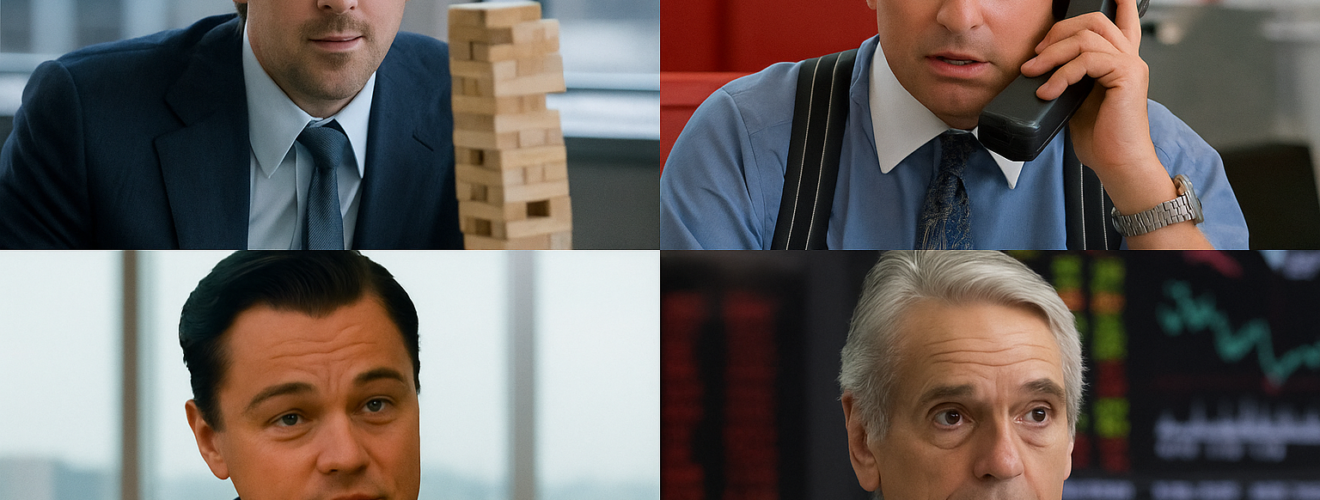Movie Scenes That Explain the Stock Market

Understanding the stock market often feels like decoding a foreign language. However, cinema has a way of making complex ideas digestible. Over the years, filmmakers have captured the drama, intensity, and psychology behind market movements through powerful storytelling. Certain movie scenes offer deep insights into how the stock market works, how investors behave, and why financial markets sometimes spiral out of control.
These movie scenes bring the world of stocks and finance to life. They don’t just entertain—they educate. Here’s a detailed look at movie scenes that explain the stock market better than any textbook.
1. “The Big Short” (2015) – Jenga Tower and Mortgage Crisis
Scene Summary:
In this scene, Jared Vennett (Ryan Gosling) uses a Jenga tower to explain the fragility of the housing market. Each wooden block represents a mortgage. As subprime mortgages stack up at the bottom—risky, unstable loans—the entire tower begins to wobble.
Why It Works:
The Jenga metaphor simplifies the 2008 financial crisis. As lenders packed mortgage-backed securities with bad loans, the system lost stability. Once defaults began, the market collapsed—just like the falling tower.
Stock Market Lesson:
Risk builds slowly. Market crashes often follow long periods of artificial stability. Understanding asset quality matters more than chasing returns.
2. “Wall Street” (1987) – Greed Is Good
Scene Summary:
Gordon Gekko (Michael Douglas) delivers a legendary speech to Teldar Paper’s shareholders. He defends corporate raiders and market capitalism by saying, “Greed, for lack of a better word, is good.”
Why It Works:
This scene captures the heart of shareholder capitalism. Gekko argues that market forces should control companies, not bloated boards or underperforming managers. The stock market becomes a mechanism for discipline and profit.
Stock Market Lesson:
The market rewards performance. Investors look for returns, and when companies underdeliver, activist investors may intervene. While controversial, this view explains stock market efficiency and its ruthless side.
3. “Margin Call” (2011) – The Realization of Collapse
Scene Summary:
An entry-level analyst discovers a major flaw in the firm’s portfolio. Senior executives meet overnight to discuss the impending crisis. They realize the firm’s exposure to toxic assets will bankrupt them unless they act fast.
Why It Works:
This moment shows how market crashes often stem from internal decisions and delayed action. The film doesn’t overcomplicate. It portrays how trading desks, risk officers, and executives react when numbers stop adding up.
Stock Market Lesson:
Markets move on information. Once insiders realize trouble, they rush to sell. The race to the exit often triggers a crash. Timing and transparency drive investor decisions.
4. “Trading Places” (1983) – Orange Juice Futures
Scene Summary:
At the climax, Billy Ray Valentine (Eddie Murphy) and Louis Winthorpe III (Dan Aykroyd) use insider information to beat the Duke brothers in the commodities market. They short orange juice futures just before the USDA releases a neutral crop report.
Why It Works:
This scene explains short-selling, futures contracts, and how news affects market prices. The chaos on the trading floor reflects real-time panic and reaction to unexpected information.
Stock Market Lesson:
Markets price in expectations. When reality differs, prices shift fast. Profits go to those who understand timing, pricing, and positioning.
5. “Boiler Room” (2000) – Pump and Dump Pitch
Scene Summary:
Seth Davis (Giovanni Ribisi) listens as a senior broker cold-calls a doctor to push shares of a worthless company. The pitch sounds convincing, but the broker aims to inflate the price before dumping it.
Why It Works:
This scene unveils the mechanics behind a pump-and-dump scheme. The broker creates hype, manipulates emotion, and traps investors with false hope.
Stock Market Lesson:
Stock markets attract manipulators. Retail investors must stay cautious and research before buying. Smooth sales tactics often hide bad investments.
6. “The Wolf of Wall Street” (2013) – Sell Me This Pen
Scene Summary:
Jordan Belfort (Leonardo DiCaprio) hands a pen to a friend and says, “Sell me this pen.” The friend replies by creating a need—asking for Jordan’s name to show the power of supply and demand.
Why It Works:
The scene distills sales and investing psychology. Stocks, like pens, rely on market demand. Successful traders understand timing, persuasion, and perceived value.
Stock Market Lesson:
Markets reflect emotion and narrative as much as numbers. The ability to sell—whether a product or an idea—creates opportunity and drives prices.
7. “Too Big to Fail” (2011) – Phone Calls Between Bank CEOs
Scene Summary:
Treasury Secretary Hank Paulson (William Hurt) frantically calls major U.S. banks to secure emergency funding for Lehman Brothers. The tension escalates as CEOs hesitate, weighing risk versus responsibility.
Why It Works:
The scene exposes the human side of financial decision-making. CEOs don’t act from formulas—they react to fear, reputation, and political pressure.
Stock Market Lesson:
Trust underpins markets. When confidence disappears, even sound companies struggle. Systemic risk rises when major players pull back at the same time.
8. “Inside Job” (2010) – Credit Rating Agencies Explained
Scene Summary:
The documentary interviews executives from rating agencies who explain how AAA ratings ended up on junk securities. They admit conflicts of interest and a lack of real due diligence.
Why It Works:
The film breaks down one of the most misunderstood elements of investing—ratings. Many investors rely on ratings to judge risk, but those ratings often reflect poor analysis.
Stock Market Lesson:
Never trust ratings blindly. Independent research matters. When incentives conflict with outcomes, bad ratings can cause mass financial damage.
9. “Enron: The Smartest Guys in the Room” (2005) – Mark-to-Market Accounting
Scene Summary:
The film explains how Enron used mark-to-market accounting to book profits from deals that never produced revenue. The company created the illusion of growth while hiding debt.
Why It Works:
The documentary clearly explains how accounting tricks inflated stock prices. Enron’s collapse shows how financial statements can mislead investors.
Stock Market Lesson:
Accounting policies affect stock prices. Investors must understand how companies report revenue, recognize debt, and handle risk. Strong fundamentals matter more than flashy forecasts.
10. “Equity” (2016) – IPO Roadshow
Scene Summary:
Senior investment banker Naomi Bishop (Anna Gunn) prepares for an initial public offering. She manages investor expectations, works with analysts, and balances demand with pricing.
Why It Works:
The scene explains how IPOs work—how bankers price new stocks, generate interest, and manage allocations. It shows the blend of hype, valuation, and negotiation.
Stock Market Lesson:
IPO pricing reflects market sentiment and risk. Early investors must weigh valuation, potential growth, and management credibility.
Final Thoughts
Movies simplify complicated stock market concepts through powerful characters and relatable storytelling. These scenes don’t just dramatize—they teach. They explain how fear, greed, timing, and information shape stock markets.
A well-crafted movie can sometimes deliver more insight than a financial report. For investors seeking better understanding, revisiting these scenes offers a fresh way to connect theory with emotion, strategy with execution.
Behind every market move stands a human decision. These movies capture those decisions with clarity, tension, and wisdom—offering investors not just entertainment, but education.













